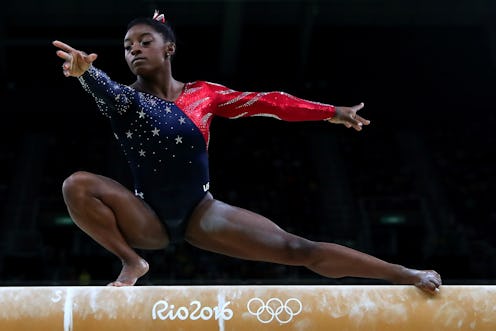The 2016 Summer Olympics in Rio de Janeiro are officially underway, and you know what that means: We're all watching with bated breath, waiting for the moment one of our favorite gymnasts scores a perfect 10, like Nadia Comaneci did so memorably in 1976. Only, that's almost impossible now. Which begs the question: How does Olympic gymnastics scoring work? Why can't today's phenoms like Simone Biles reach what was once considered the pinnacle of gymnastics scores? Well, it has to do with a change in the scoring system that occurred in 2004. Let's discuss.
First, zip back in time with me to the '76 Olympic Games in Montreal. There, 14-year-old Romanian gymnast Nadia Comaneci turned out a once-in-a-lifetime performance, earning the first perfect 10 ever to be scored in an Olympic gymnastics event. In a recent interview with Bustle, Comaneci confessed that she initially thought the score was a mistake. In fact, many people watching did — it was a score so unprecedented that the scoreboard couldn't even register it, instead blinking as "1.00."
Over the next decade, though, that once-elusive score became increasingly common. The veracity of Comaneci's score was uncontested, but once she was awarded her 10, it seemed to open the floodgates of a flawed scoring system. That system, which was based on a top mark of 10.0, allowed judges to score based on overall performance and precedence. They did so by first determining a routine's start value (no higher than 10) and making deductions from there. The idea was that you could conceivably reward the most elite gymnasts in the field — the ones who deserved more than a 10 — by forgiving any tiny errors they made during an otherwise-outstanding routine.
Then came the 2004 Summer Games in Athens, when American gymnast Paul Hamm was awarded the individual all-round gold despite stumbling onto the judges' table coming off the vault. The win was upheld, but an investigation by the International Gymnastics Federation found that South Korean gymnast Yang Tae Young had been incorrectly scored on his parallel bars routine, which contributed greatly to the results of the competition. Three judges were suspended for this, and a new system to prevent such scoring errors from occurring in the future was developed.
Instituted in 2006, the International Gymnastics Federation's new Code of Points divides judging between two panels. The first panel judges the gymnasts on the requirements of their routine, the difficulty level, and the connections of the routine. The scoring for this panel — which consists of two judges and is known as the D (for difficulty) panel — starts at zero, and then adds points accordingly. There is no set maximum score on this scale, so theoretically, a gymnast could rack up a huge number of points by packing their routine with difficult techniques; however, the highest scores on this scale typically fall in the six to seven range.
The second panel judges the gymnasts on the execution of a routine. The scoring for this panel — which consists of five judges and is called the E (for execution) panel — starts at 10, after which points are deducted accordingly. To arrive at the final score for a routine, the scores from the two panels are added together.
There is also a third panel, consisting of two judges, known as the Reference panel. This panel spot-checks the E panel's scoring for accuracy. The only time the Reference panel would affect a gymnast's score is if the E panel made a mistake in judging the Execution Score; in that case, the Reference panel would adjust the E panel's score accordingly.
Comaneci explains to Bustle on the possibility of scoring a 10 under the new system: "I don't think you can do it! You can only get a 10 in execution, and the highest to date is 9.5. So with the new scoring, I don't think it's possible." But while it may no longer be feasible to match Comaneci's historic 10, gymnasts today are certainly still delivering performances most audiences would deem worthy of a "perfect score." The reality, though, is we've just had to learn to readjust the way we look at scoring.
The new system is open-ended, designed to allow for greater distinction between individual gymnasts' scores. For example, you may have a gymnast perform a show-stopping routine the crowd loves; however, that same gymnasts might also make a few technical errors along the way. This would leave the door open for another gymnast to outscore the first one if they perform solidly on both sides of the spectrum — particularly since execution errors are penalized more now, costing one full point, as opposed to the old system's eight-tenths of a point.
A really great score under the new system would be in the 15-16 range, with anything over 16 being considered exceptional. Because there isn't actually a set maximum score on the difficulty scale, there isn't technically a "highest possible score." However, here are two points of reference: The highest score under the current system is 17.1, which came by way of Nadia Luikin on the uneven bars in 2008. In the 2016 Olympics, Simone Biles scored a 16.0 and 16.10 on two incredibly difficult vaults.
So yes, the "perfect 10" is essentially a thing of the past. But while it was an easy-to-understand milestone, the fact that it no longer exists might actually be a good thing. Today, gymnasts are rewarded for pushing the boundaries of the sport in a way that wasn't reflected under the old system. Just think of the old perfect 10 as a cap to the gymnasts' potential scores, whereas with the new system? Well, let's just say the sky is the limit.
